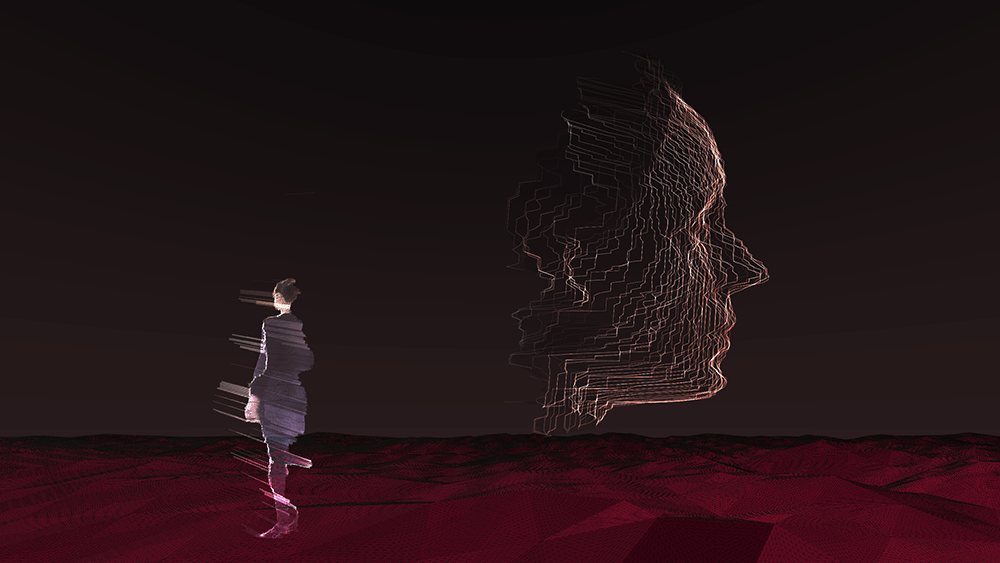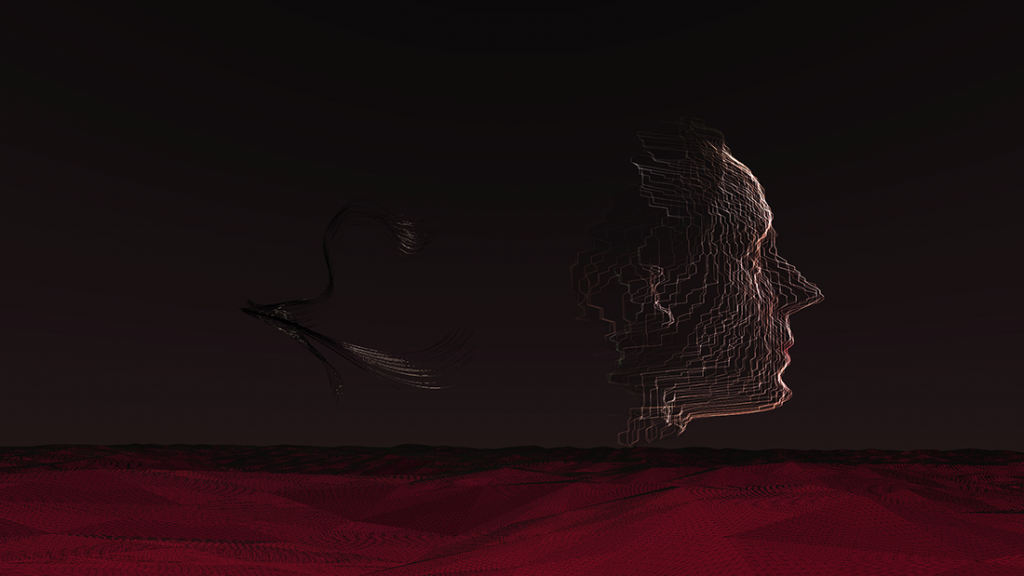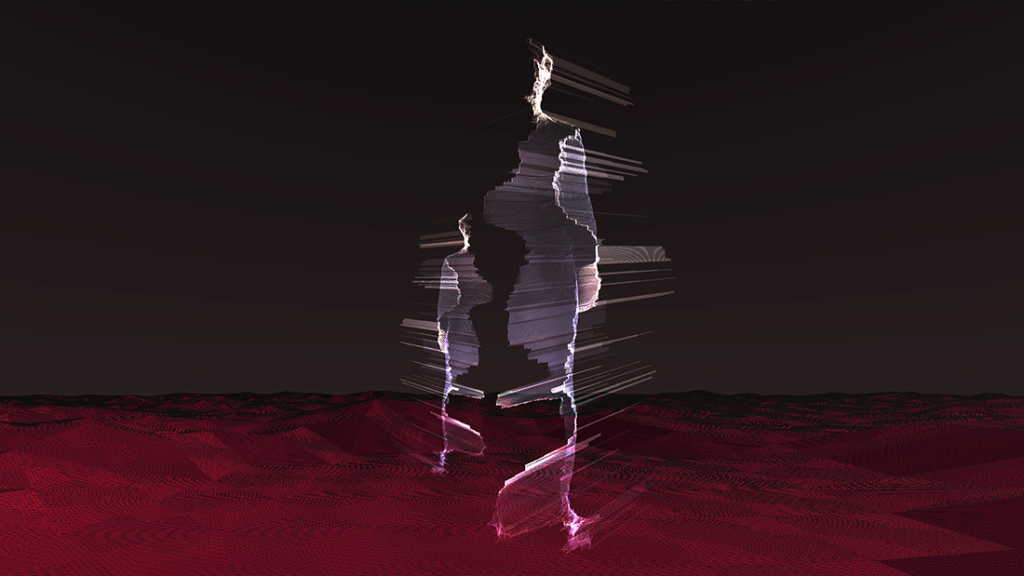Interview by Lidia Ratoi

Poetics. Even the word itself sounds ethereal. In an almost synesthetic manner, hearing poetics triggers a reaction – a dreamlike state of serenity and beauty. Poetry is delicate. Exquisite. Fascinating. And these are the exact words one feels the need to use when describing Marta Di Francesco’s work. Her latest piece is Janus VR, an experience inspired by the two-faced God of time.
Time is a constant presence in Di Francesco’s travail. It is analysed through its relationship with space, dilated, altered, and split. It is the leading character, action or setting. It is viewed as something we do not have enough of or as something that could be increased to unlimited potential.
Janus VR focuses on time as a dual identity of both past and future postures. Through volumetric capture, the viewers are entranced in a dance and dialogue between two dancers who reveal to be passed and future.
Viewing it, it comes as no surprise that the piece originated in a dream the artist had. It is an ethereal piece with subtle colours and symbolic movements, images and ideas. The two entities are seen both separate, each with their own existence, and together – now facing different directions, suggestive of the flow of time.
Janus is not singular in Marta Di Francesco’s pieces in its use of deity-inspiration and mythological characters. Ishtar is a piece exploring metamorphosis and liminality, inspired by the Assyrian mythological journey of Ishtar into the underworld, a journey from abstraction to rebirth, from the wrapping geometries of darkness to grace, pulsing between the violence of change and the ever-radical beauty of morphing angles & lines”.
In Ariadne’s Thread, the myth of Ariadne and Theseus is revised – Ariadne no longer focuses on helping Theseus out of the labyrinth, only to be abandoned by him, but reclaims her own life and faces the Minotaur herself, accepting it as a part of herself.
The portrayal of these worlds is true to Di Francesco’s aesthetic persona – while focusing on Gods or mythological creatures, the traditional overpowering, loud and violent appearance is replaced by a subtle, gentle visual creation, replacing human anger with an alluring sense of tranquillity.
Feminine conventional elements and the empowering of females are natural traits which highlight the stories with kindness – women are instinctively viewed as forceful, without having to win battles. In the world created by Marta Di Francesco, battles seem to be replaced by contemplation, and negative elements pale while facing their own futility.
However, this dream-like world is not far from our own existence, and it is portrayed in a manner which doesn’t allow the denial of it. In Reverb, by using slit scanning techniques, which “allow determined points in time to leak and blend all into one”, the morphology of the human body and of time and space is altered to a point in which the actual, real-world identity of those can be easily confused with the imaginary one – the images seamlessly flow from one posture to another, while the music creates an overall narrative, which immerses the viewer into this seductive state of mind.
Writing about Marta Di Francesco, one could initially be tempted to call her a creator of worlds. But viewing all of her works, from Crystal Delays, which “captures the physicality and poetry of the dancer as he forms movement” to The Waves, which deals with questions regarding identity, a human cannot help itself but ask why such simples postures of the mortal condition, for instance, time, body movement, identity or empowerment are not more frequently questioned.


You are a new media artist who uses technology to merge code and poetics. For those that are not familiar with your background, could you tell us a bit about it and how and when did the interest in technology, art and science come out?
I have a mixed background and a multidisciplinary approach to my work. Art has always been present. But as a kid, I was quite good at maths, so I picked science and maths studies. Math was fascinating to me mainly for its use of imagination and abstraction, something that – eventually, I discovered – it shares with poetry. When angst and existentialism hit me hard as a teenager, I started devouring arthouse films and poetry, from symbolists to city lights and punk.
What fascinates me about poetry and both maths and code is the use of metaphors to create new forms, new ontological possibilities, and new paradigms. This ability to make the invisible visible; creates the tension I am interested in between the order of maths and the raw free fluid chaos of expression in free-form poetry, prose or music improvisation.
After graduating, I worked in animation and film before dedicating myself fully to my practice, merging video and code. Whilst code is the grammar of my visual work, poetry is the constant thread that runs through it. The poetics in my practice refers to an emotional, existential and also conceptual and critical approach that can be both intimate and radical.
I am interested in exploring identity and consciousness through meditative and contemplating aesthetics that combines volumetric depth data with hypnotic, procedural textures.
As I merged volumetric capture with image processing, I developed a technique that allows me to explore the contrast between speed and subtleness, between the ever-changing flashing pulse of the textures and the knots and lines that resonate with the stream of consciousness. I am interested in the collective consciousness and this idea of interconnectedness and existence as a piece of fabric that has many interwoven metaphysical, digital, and poetic threads.
In the Metaverse, identity is bodiless and genderless. Virtual Bodies are connected together by a common digital, metaphysical thread, whose dots and lines weave into each other. Interconnectivity amongst living things and through time and space is explored in many disciplines, including science.
Most recently, I have been interested in magnetic fields and especially inspired by the theory of morphic resonance by Rupert Sheldrake, according to which all living things are in tune with each other, united by collective memory or collective consciousness.
In your practice, you explore ‘digital identity and its fragmentation through digital bleed, time displacement video processing, and the sculptural quality of time in volumetric aesthetics’ (in your words). Could you expand more on this idea?
Identity is usually connected to the body, but in the metaverse, there is nobody, so the sense of self is not anchored but fluctuating: multiple identities in different realities blend with one another. Little broken pieces of ourselves are scattered in different fragments over screens and are as multiple as the visits, the clicks and the transactions.
The self becomes data that gets pulled, analysed and put back on the net. In biometrics, identity becomes authenticated in correlation to a template, a threshold; when identity becomes data, it’s possible to be authentic without being “real”.
I am interested in these moments of transition and displacement, as both accelerations and this ever-constant – ad infinitum – self-mirroring of the metaverse create new temporalities.
I started experimenting with time displacement at the beginning of my practice, employing slit-scanning, a technique that allows determining points in time to leak and blend all into one, making it possible to glimpse into the past and future at the same time: a temporal vortex creates a hole which allows us to see into the future as it pours out into the present.
I then started combining volumetric capture and image processing to create an aesthetics that could explore a new temporality, four-dimensional impermanence, that I define as the sculptural quality of time.
I was looking for aesthetics that could be spiritual and poetic and translate that radical break with traditional space-time representation, and in this volumetric aesthetics, I found the kind of transcendental quality I was looking for. I started experimenting with the sculpting of these metaphysical threads through a process that has much resonance with traditional sewing and that I describe as a kind of ‘digital weaving’.
How I process these images in the video is key to my practice. I am interested in procedural work combined with human intervention at the very end of the process. I would use a random procedural technique, but I would then tweak it hand-by-hand in an operation that is as much automated as much as manual.
Once I process all the frames of my video, I would go back and paint over it frame by frame, in a very long, methodical process that feels deliberately labour-intensive, slow and meditative. The human touch has its last word on the work, in a way. As the algorithm spits out the output, there is a final human intervention in the work.
J A N U S VR is a poetic VR art experience that questions the effect of time on our identity. What is the intellectual process behind this project? What do you want to bring to the audience that interacts with J A N U S VR?
Janus is a meditative and contemplative piece that invites the audience to experience a sense of awareness of both the future and past by finding themselves at one with the present.
The piece is more immersive than interactive, and the use of VR as a medium is key since virtual reality is a space where the perception of time is altered and dilated, a place to experience a deep sense of presence and experience dance, as an art form that moves through time and space.
Janus is a project that initially came out of a dream. At that time, I felt I was in a particular period of transition in my life. In addition to that, we are in times of political, economical and social transformation, and existential unrest is inevitable. Brexit and Trump’s election are a symptom.
The piece evolved from the awareness of this delicate liminal space, the threshold of an era that I believe will be defined by our ability to learn from the past and take the time to reflect in order to move forward. A grounded sense of presence is needed in moments of transition as they are often accompanied by displacement and loss of identity.
The ability to regain time and attention is necessary to understand the moment and take action in response to it. The future is made by the same threads that control the past: they are connected and interwoven with each other.
In times when a worrying resurgence of nationalism and populism have re-emerged, it is key to reflect on the lessons learned from the past. During the making of the project, I was inspired by Walter Benjamin’s writings on history and critique of progress and by many interesting studies, research and notions around subjective time and mental time: from Quantum physics, Neuroscience, as well as Philosophy.
Saint Augustine, as early as AD 400, already explained time as the continuous exercise of reconstructing the past and anticipating the future, using the example of music. When he refers to listening to a musical note, he states that he is not merely listening to one note at a time, but his brain creates a collection of the experience of listening to the music by creating meaning — that comes from the note and the memory of the previous notes, as well as the anticipation of the future notes.
The ability of the brain to remember is equal to the one that anticipates the future. Research in Neuroscience revealed that, in fact, when we remember the past or think about the future, we do use the same area in the brain cortex. Memory is essential for long-term thinking and, in a way, a tool for the future.
Time defines us, and yet it eludes us now more than ever as we are in a state of constant panic, acceleration and distraction. Time and self are connected, and subjective time is related to consciousness. The ability to travel in mental time is regarded as being at the heart of consciousness and at the centre of human cognition.
I am interested in the audience experiencing a sense of “now” but not intended as a way to act on ‘impulse’, but rather as a capacity to experience being present and aware of both past and future in order to create the necessary mental space to regain time, as space for context and critical thinking.
I am interested in the idea of regaining time as a form of attention and resistance. As the economical, social and environmental crisis continues, it feels like the future is closing in on us, and the sense of — what Franco Bifo Berardi describes as ‘impotence’ as being able to understand and critically decide ‘in time’ is creeping in. The critical ability exists in the temporality of our brain. Distraction has a negative impact on memory, attention and on imagination.
In this era of distraction and acceleration, it’s important to defend the right to time. Regaining presence can allow for more attention and long-term thinking. Virtual Reality is a great medium for abstract speculations, but action needs to be taken IRL.
We are time – and despite our mortality defining us more than any other thing, we are experiencing a deep lack of time consciousness. The battle against distraction and the liberation of time and attention is a moral, political struggle. Distraction causes loss of time consciousness, and it prevents us from being aware, being agents, active, creative and most importantly, participants.
What directions do you see taking your work into?
I am curious to continue exploring new aesthetics within the speculative spaces of mixed realities, experimenting with generative, procedural and real-time technology, as well as continuing to work with video. I am also excited to focus more on writing and further explore the use of prose in my work.
As I continue exploring identity, the question of othering and this idea of regaining time as a form of resistance, I am also increasingly concerned about the idea of Meta/MagicVerses as artificial paradises, in a way so that mixed realities can be essentially Baudelairean paradises.
The sense of impotency and standstill of the current times are somewhat related to this infinite self-mirroring and elusion of reality as a definite frameable target and context for action.
I am interested in continuing to explore new temporalities and slowness, questioning the idea of race towards progress and obsolescence and durability. One of the things I have been questioning about my practice recently is, for example, my responsibility in the use of tech devices, for example – in regard to their life span, their sourcing, recycling and sustainability.
How do you cope with creative desperation?
I think the feeling of desperation is always consciously or unconscious prior to the “creative” process. Creating the work is a way to fill the void. It’s when you’re in that state that you write a few lines or/and create a piece.
And then, when you look back, you realise that it’s the work that has found you. It’s a rope thrown at you not to drown. A way to stay afloat. For me writing or making new work is a way of coping.
I guess that’s why I am not sure about AI’s poetry and “AI as artist”, but I believe in Artists who use AI as a tool to express themselves.
One for the road… What aren’t you afraid of?
The dark. It’s more visible than a screen. It is not shiny and reflective. It’s opaque, fluid, and inscrutable.






